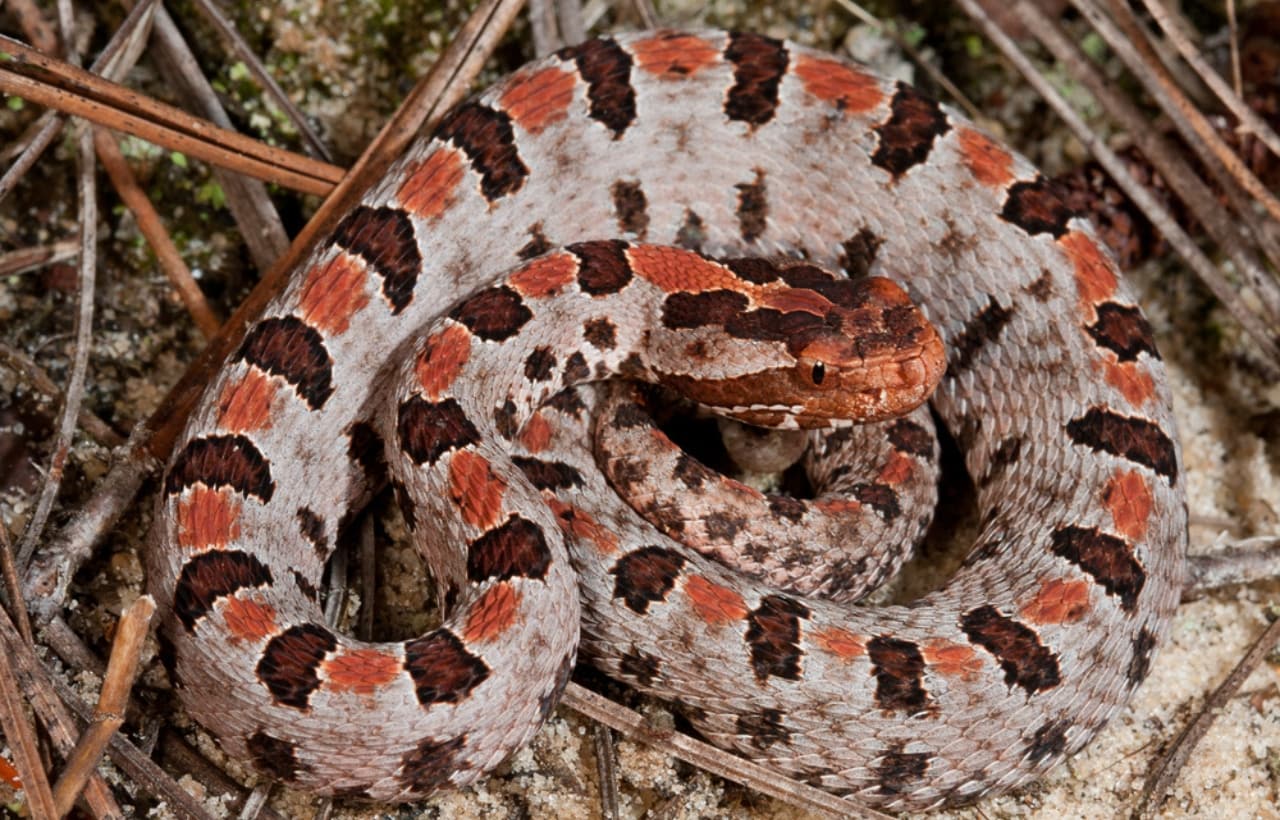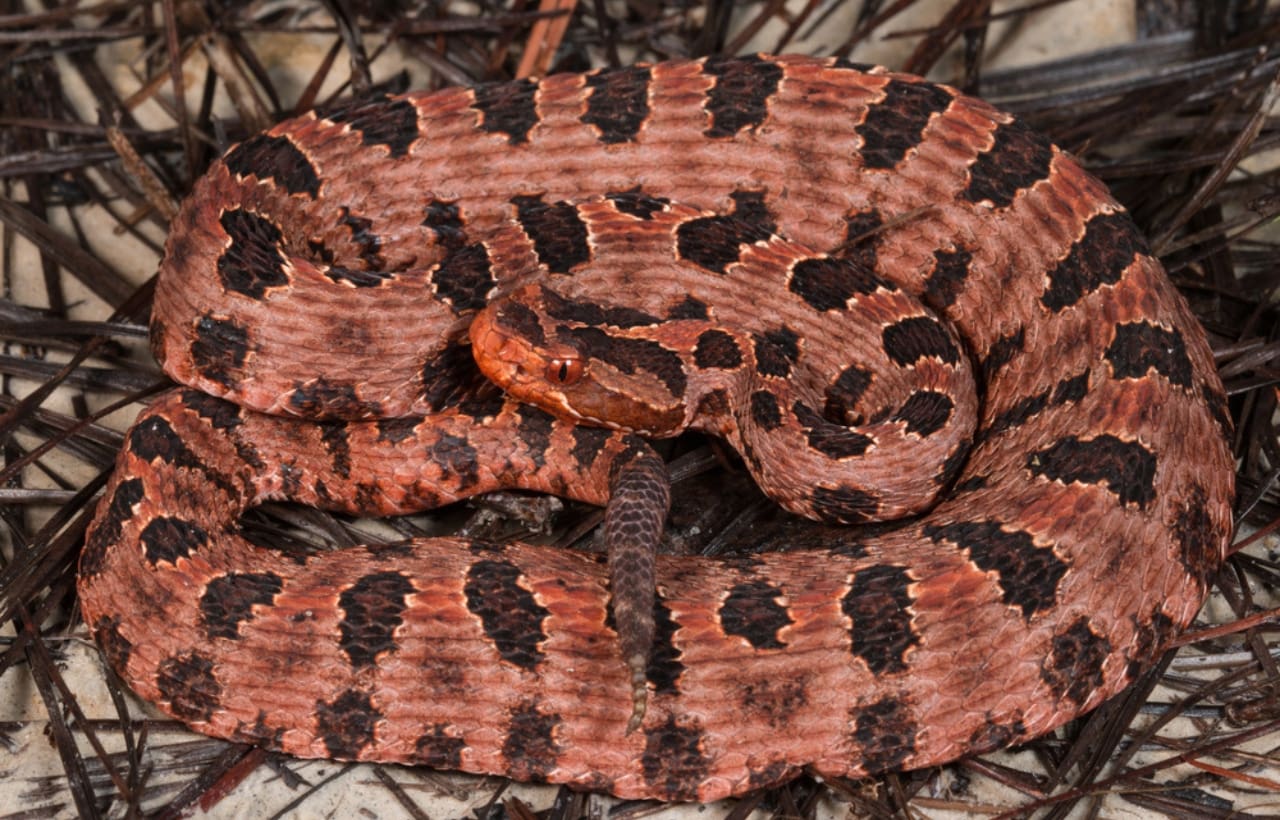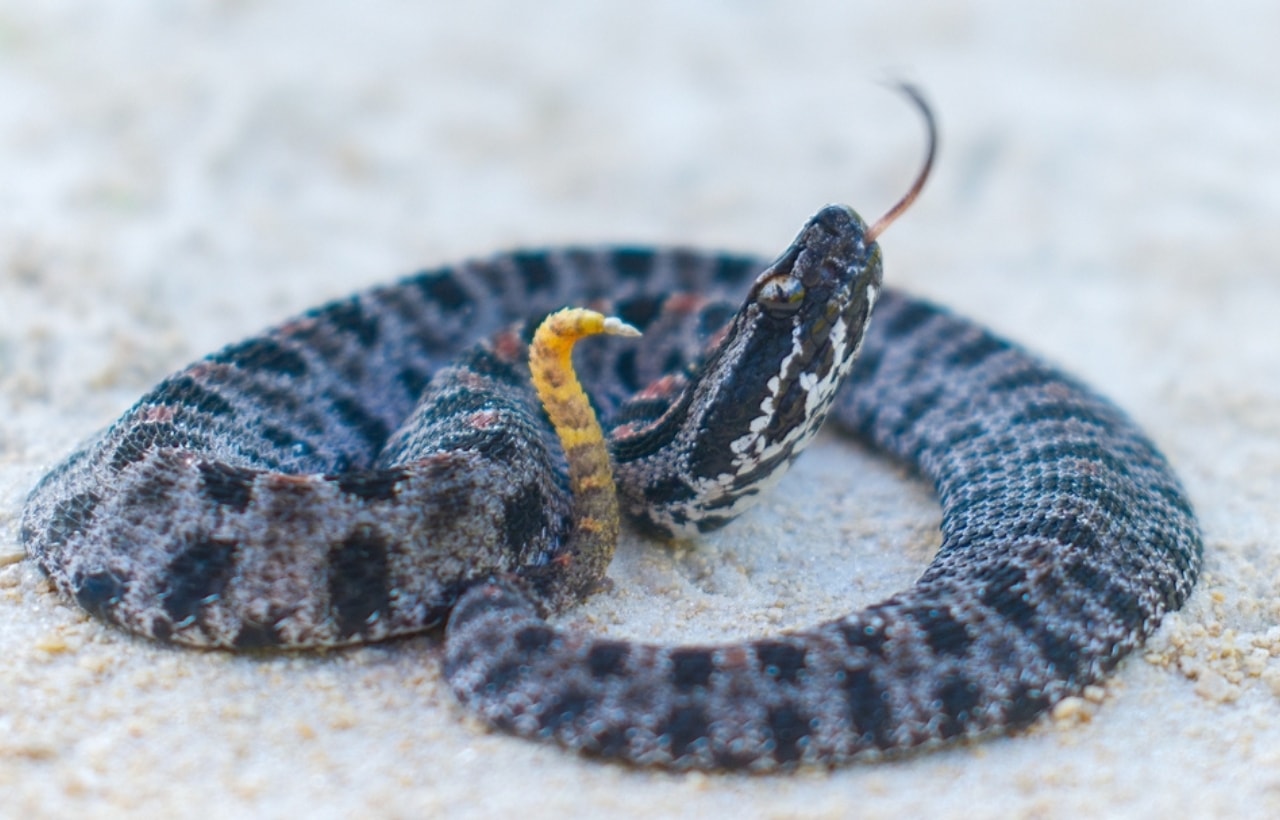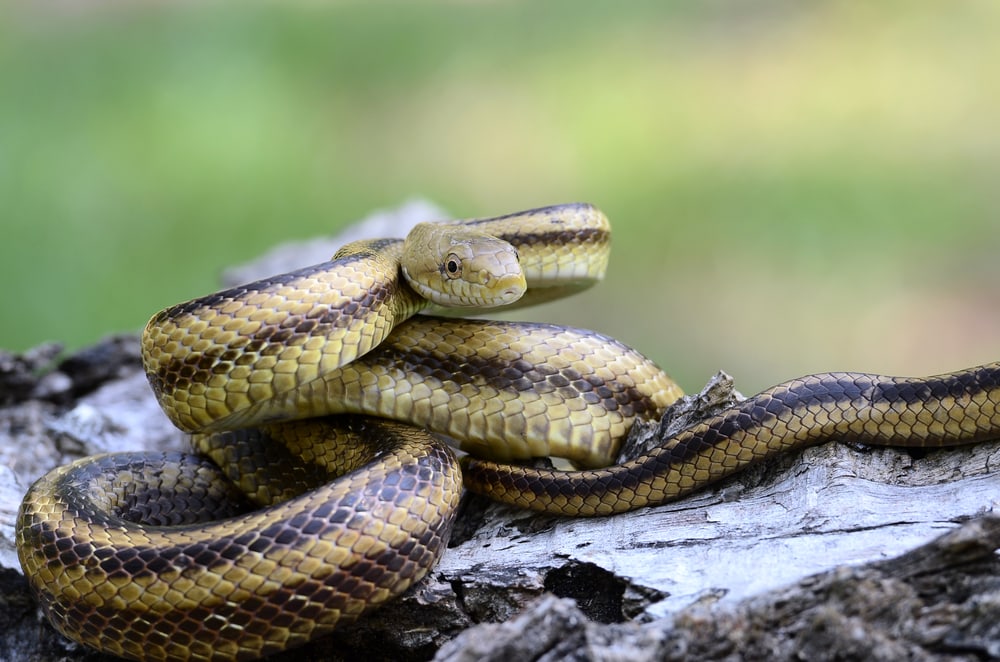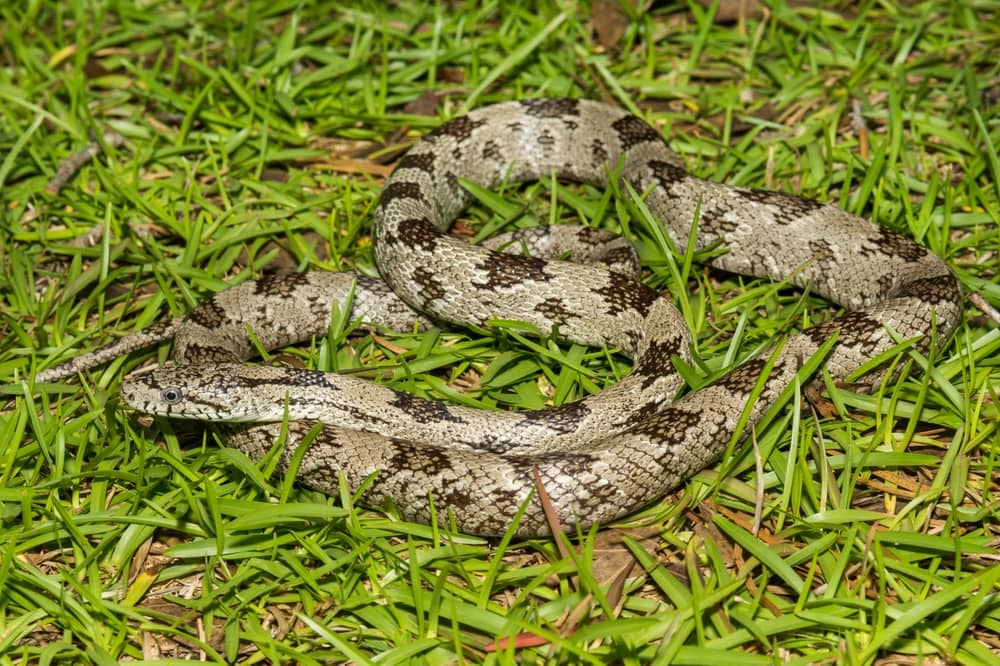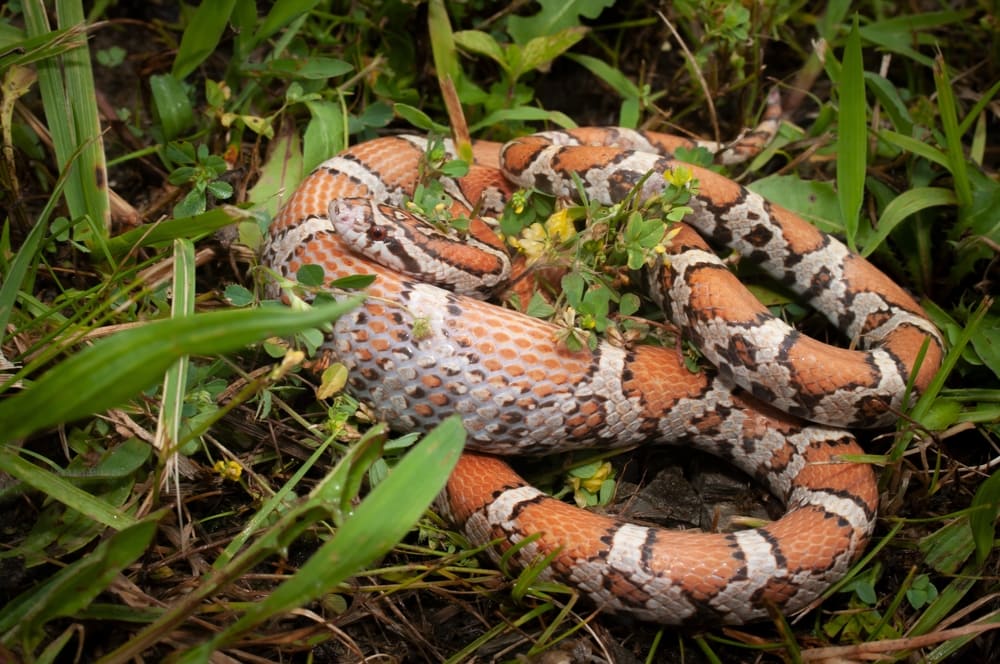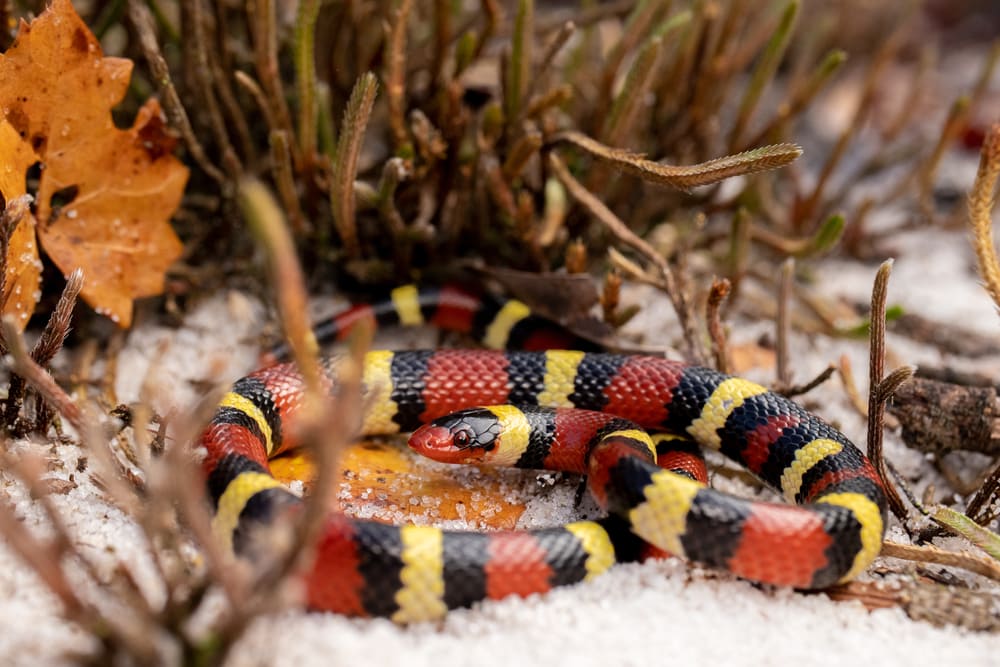Did you know that there are more than 3,400 snake species found around the world? About 150 of these species are found in North America.
Georgia is one of the top states for most snake species. There are 46 species of snakes in Georgia. Six of these species are venomous. The rest of the snakes in Georgia aren’t venomous, but some can still have a painful bite.
In this comprehensive Georgia snake identification guide, we’re going to talk about the most common types of snakes found in Georgia, what they look like, and where they’re most common.
30 Different Types of Snakes in Georgia
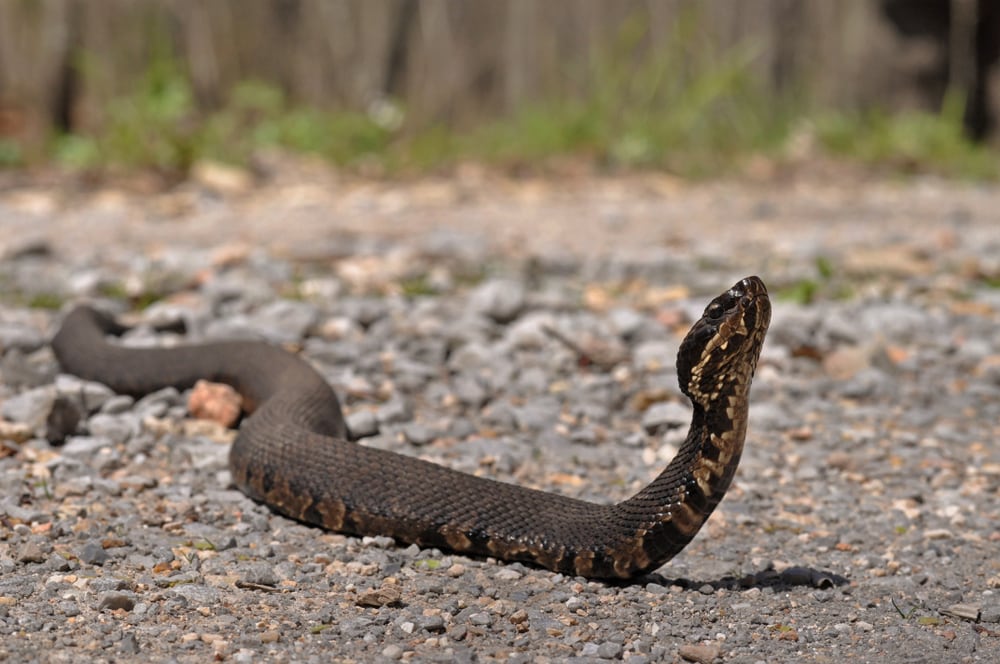
There’s a common phenomenon that people fear snakes, even if they’re not poisonous. More than 70% of snakes in Georgia are non-venomous.
Unlike some other poisonous creatures, such as frogs, vibrant colors on snakes aren’t a good indicator that they’re poisonous. There are several snakes in Georgia that have colorful bodies or underbellies. However, most aren’t poisonous at all.
The first six snakes on this list are the six venomous species found in Georgia. The rest of the list includes non-venomous species.
1. Copperhead
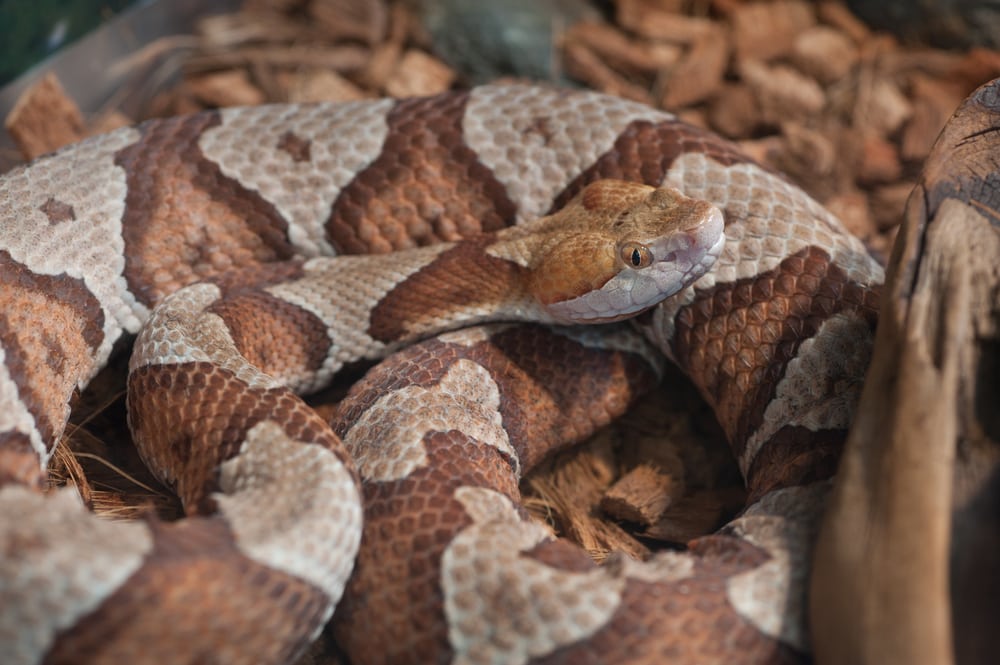
Copperheads are heavy-bodied venomous snakes. They can reach up to 40 inches (102 cm) in length. The background color of a copperhead can range from light tan to brown.
They have dark hourglass-shaped crossbands. The bands are narrow on the sides and thicker at the center of the spine. They also have a distinct large, triangular head shape.
Copperheads are common in the eastern and central US. They’re mainly found in forested areas in most of Georgia. They’re also common in residential areas. They’re absent in most of Florida and south central Georgia.
Copperheads should be avoided if encountered. However, their venom isn’t as potent as other venomous Georgia snakes. Copperhead bites resulting in fatalities are very rare.
2. Pigmy Rattlesnake
The pigmy rattlesnake is a medium-sized venomous snake. They have the ability to produce a warning rattling sound. But their rattle is small, so it often goes unheard. These snakes are found in most of Georgia, except for the northernmost region.
There are three subspecies of pigmy rattlesnakes. Two subspecies occur in Georgia, including the Carolina pigmy and dusky pigmy rattlesnake.
The Carolina pigmy rattlesnake is gray or tan. Some individuals in northern Georgia are reddish-orange.
The dusky pigmy rattler is bluish-gray to black. They have blotches on their back and sides with an orange or reddish stripe along their spine.
Pigmy rattlesnakes are more common in the southern Coastal Plain region. Smaller populations occur in the Piedmont region. The dusky pigmy lives in moist and woodland habitats, including mixed forests, marshes, and swamps. The Carolina pigmy rattlesnake prefers dry habitats, such as xeric pine forests.
These snakes use an ambushing technique to capture prey. They stay hidden in leaf litter and wait for prey to come across their path.
3. Timber Rattlesnake
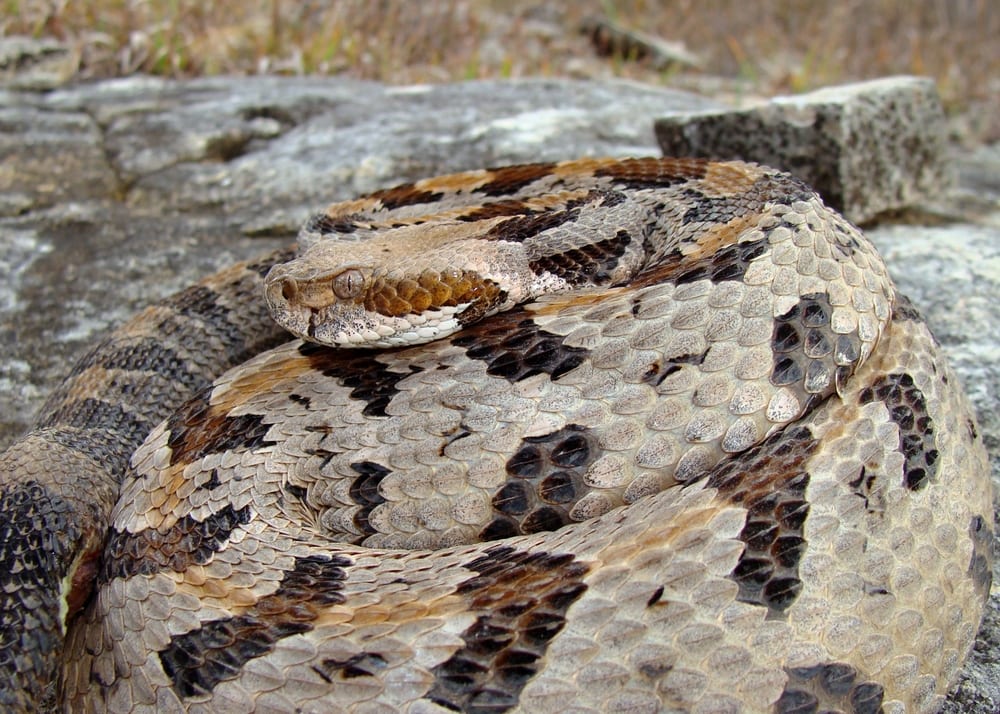
The timber rattlesnake is widely distributed throughout most of Georgia. Species in the Coastal Plain region of the Southeast are referred to as canebrake rattlesnakes.
Timber rattlers are heavy-bodied snakes that can reach up to 60 inches (152 cm) in length.
Timber rattlesnakes are typically brown, black, or yellowish. Canebrake rattlers are lighter in color. Most individuals are gray. These snakes have a series of chevron-patterned bands along their back that extend to the sides. They also have a light-colored streak that extends down the spine.
These snakes live in a wide variety of terrestrial habitats. They can be found in hardwood and pine forests, mountains, agricultural areas, and lowland cane thickets. Population sizes are limited in urban areas.
They’re seen more often in the late spring. They hibernate during the winter. Timber and canebrake rattlesnakes spend most of their time hiding under ground coverage in a coiled position. They shelter here and wait to ambush their prey.
4. Cottonmouth
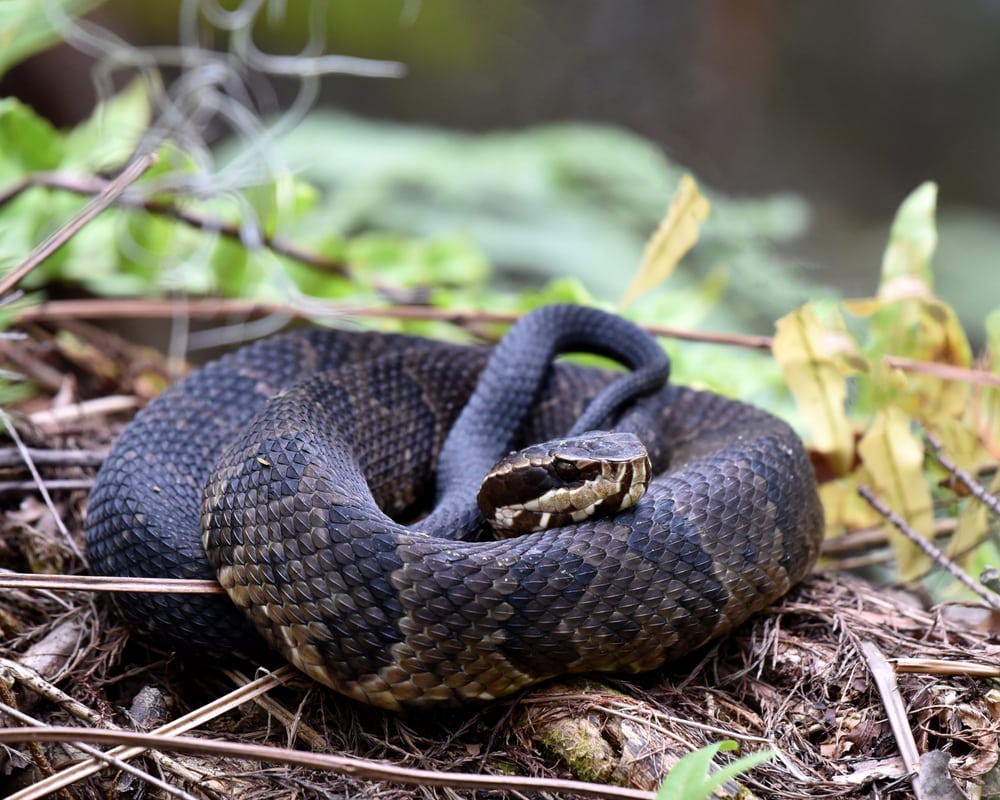
The cottonmouth is one of the most well-known venomous snake species in the Southeast. Cottonmouths are a semi-aquatic species commonly called water moccasins.
They’re mainly found in freshwater habitats, such as vegetated wetlands and cypress swamps. Cottonmouths are typically brown or dark yellowish-tan with darker crossbands. Mature individuals are darker than juveniles, and sometimes completely black.
The range of a Georgia cottonmouth is mostly limited to the Coastal Plain region. Smaller populations can be found scattered throughout the Piedmont region.
Cottonmouths get their name from the white color in their mouth. It exposes it when it feels threatened. They will strike humans if they’re disturbed. The venom of a cottonmouth can be deadly to humans.
5. Eastern Coral Snake
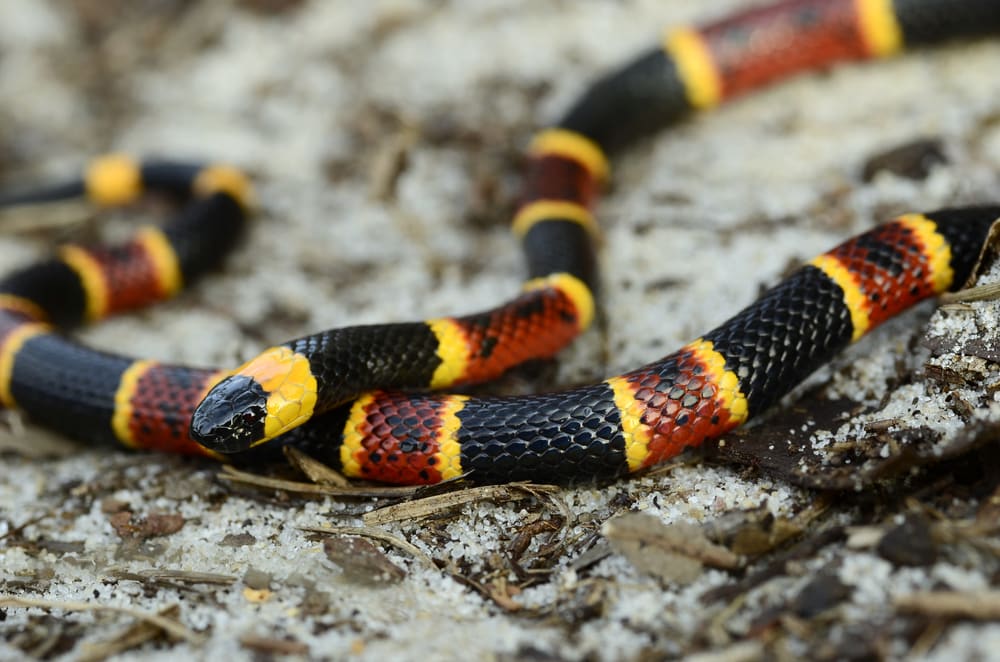
Eastern coral snakes are colorful, venomous snakes found in the southern Coastal Plain region. These snakes have red, yellow, and black bands. They have a prominent yellow ring around their neck. The black and red bands are thicker and separated by thin yellow bands.
They’re also called the harlequin coral snake. They look similar to scarlet kingsnakes, but their band colors are ordered differently. Eastern coral snakes are also less vibrant than scarlet kingsnakes.
Larger populations of these snakes occur in Florida. Georgia populations are scattered. They spend most of their time underground, so they’re not seen often.
Although these snakes avoid human contact, they can inflict a poisonous bite that’s dangerous to humans. Their habitat consists of well-drained flatwoods, swamp edges, and wet hammocks. They’re uncommon in residential areas.
6. Eastern Diamondback Rattlesnake
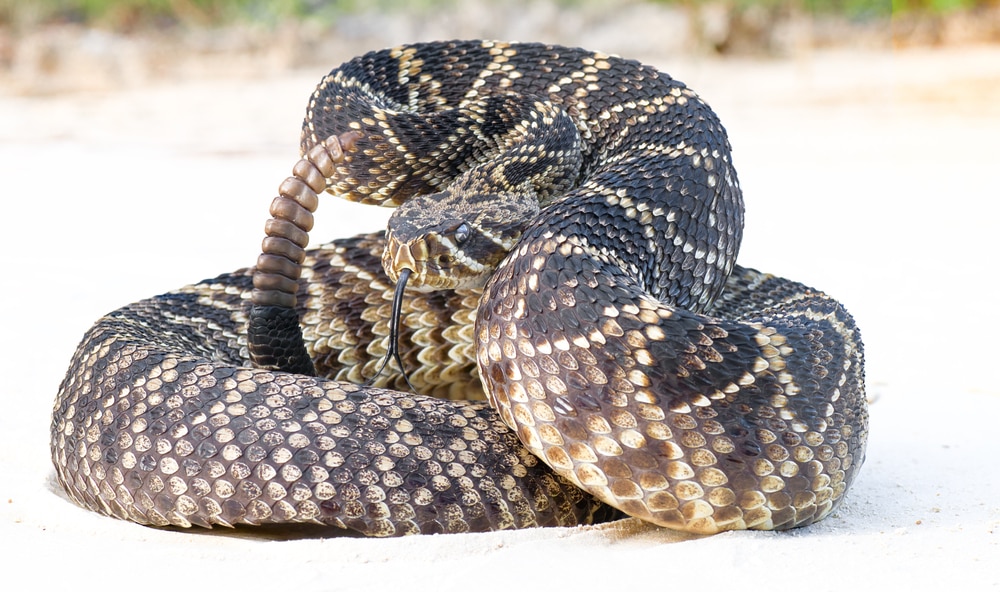
The eastern diamondback is the largest rattlesnake species in the world. They have heavy bodies with wide heads. They can reach lengths up to 72 inches (188 cm) and weigh more than 10 pounds (4.5 kg).
Eastern diamondbacks are named for the diamond pattern they have on their body. Most individuals are brown, tan, or yellowish in color. They’re more active during the day, especially in mornings and evenings during the summer.
These snakes are native to the Southeast. In Georgia, eastern diamondbacks are found in the Coastal Plain region. They live in forested habitats and open longleaf pine woods. Populations in Georgia have declined due to habitat loss and fragmentation.
The bite of an eastern diamondback rattlesnake can be lethal to humans. These snakes inject a toxic venom, known as hemotoxin. This can cause tissue damage and kill red blood cells.
7. Eastern Green Watersnake
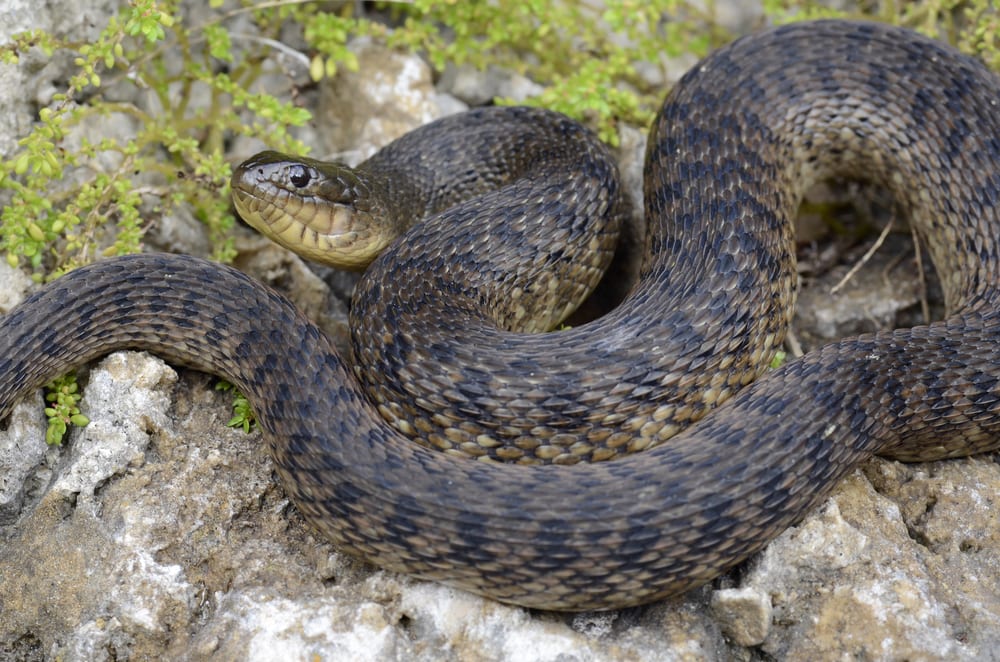
The eastern green watersnake is mainly found in southern Georgia. A scattered population exists along the central eastern border of Georgia and South Carolina. These snakes live in heavily vegetated aquatic habitats. They can be found in swamps, marshes, lakes, slow rivers, ponds, and ditches.
Eastern green watersnakes are most active during the day. They forage for food in and around their water habitat. Most of their diet consists of amphibians and fish.
Adults are greenish-brown on their back and have a pale belly. Juveniles are patterned with around 50 dark bands down their back and sides.
Eastern green water snakes are the largest water snake species in North America. They average 30-55 inches (76-140 cm) in length. These snakes aren’t venomous, but they won’t hesitate to bite if they feel threatened.
8. Brown Watersnake
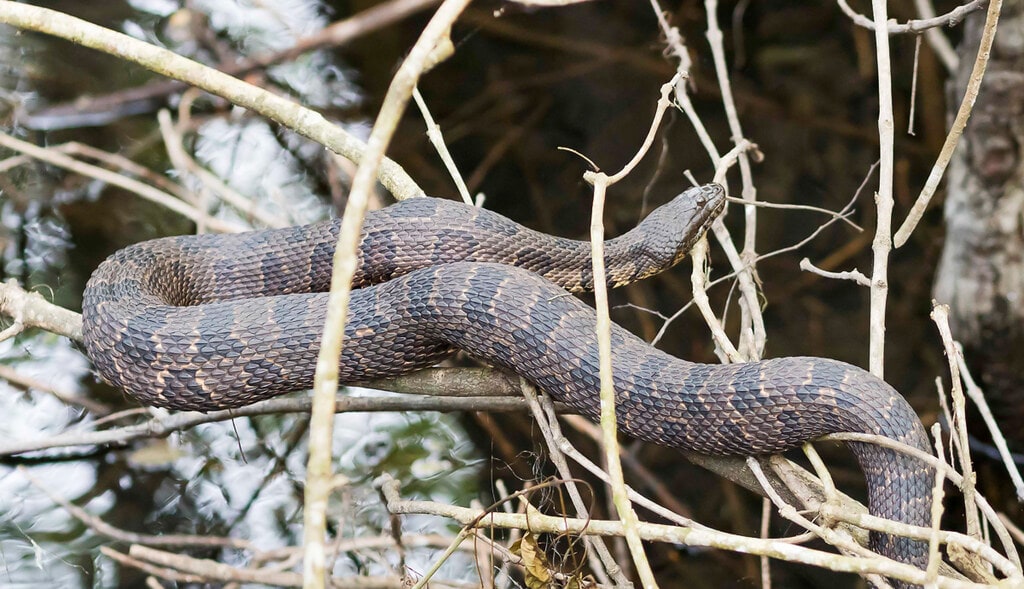
Brown watersnakes are heavy-bodied snakes that range from 30-60 inches (76-152 cm) in length. They’re a semi-aquatic species. These snakes prefer flowing water habitats, such as rivers and creeks. Their diet mainly consists of fish, which attracts them to permanent bodies of water.
Brown waternsnakes can vary between light to dark brown. Adults have alternating dark brown square blotches down their spine and on their sides. These snakes can be confused with copperheads.
However, they can be distinguishable because copperheads have connected bands with an hourglass-like shape instead of square.
Although not venomous, brown watersnake bites can be painful. They’re widely distributed throughout the Piedmont and Coastal Plain regions of the Southeast. Their range extends from southern Virginia south to Florida.
9. Banded Watersnake
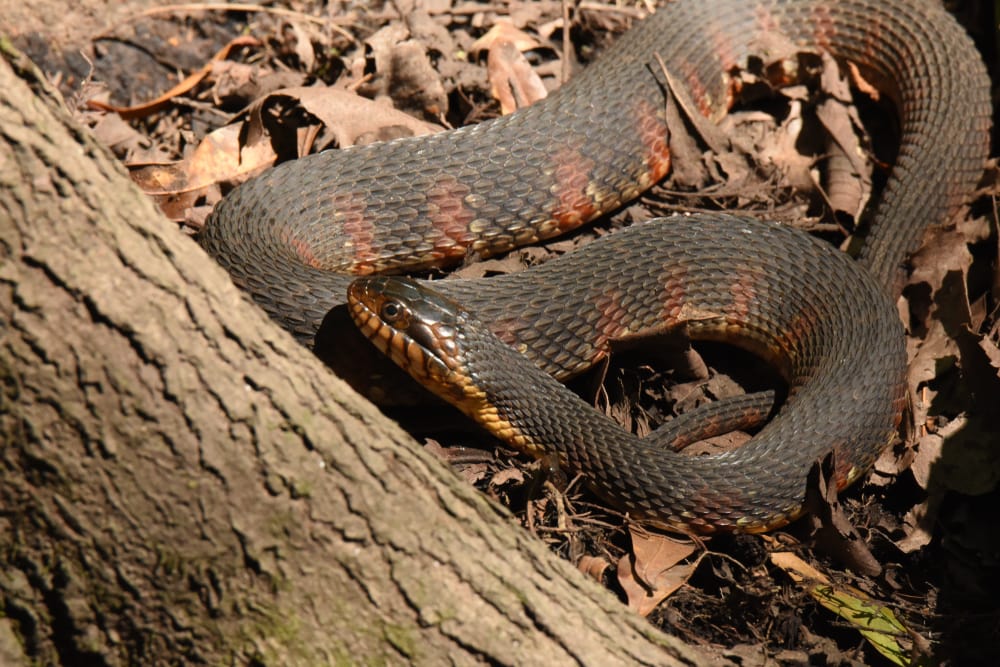
Banded watersnakes can be found throughout the Coastal Plain regions of the Southeast from North Carolina to southwest Alabama.
This snake is a semi-aquatic species that can live in virtually any freshwater habitat. They’re found in swamps, marshes, wetlands, ponds, lakes, streams, and rivers. They like to forage in shallow waters for fish and amphibians.
Adults are medium-sized, ranging between 24-48 inches (61-122 cm) in length. Most adults are uniform in color. Their coloration can vary from light brown, reddish-brown, or black.
They have dark crossbands that are thicker in the center and become more narrow on the sides. This crossband pattern is inverted compared to copperhead crossbands.
Banded watersnakes are active during the day and at night. To warm up during the day, they bask on logs or vegetation hanging over the water.
10. Northern Watersnake
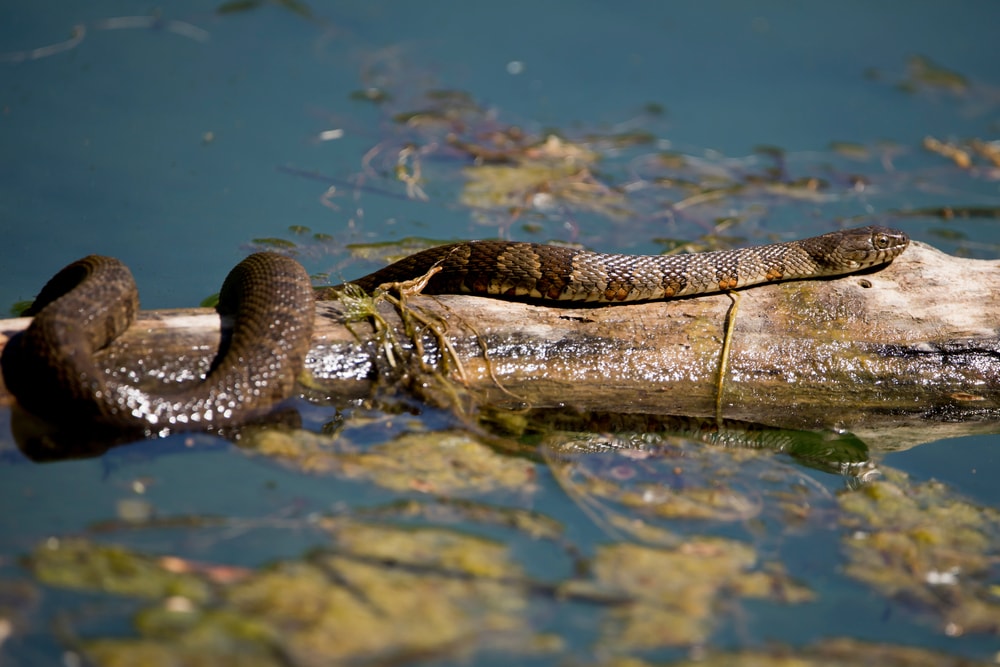
Northern watersnakes are medium-sized snakes that can have a gray, tan, or brown appearance. Their coloration is more vivid as juveniles. Northern watersnakes have square blotches that alternate on their back and sides. Sometimes the blotches can connect.
These snakes can be mistaken for the venomous cottonmouth. However, cottonmouths have bands that connect throughout their body, rather than separated blotches.
Northern watersnakes are found in eastern and central North America. Their range in the east includes the Piedmont region and mountains. Their range in Georgia includes the northern half of the state.
They’re commonly found in lakes, ponds, marshes, streams, and rivers. This is where they feed on amphibians and fish.
11. Queen Snake
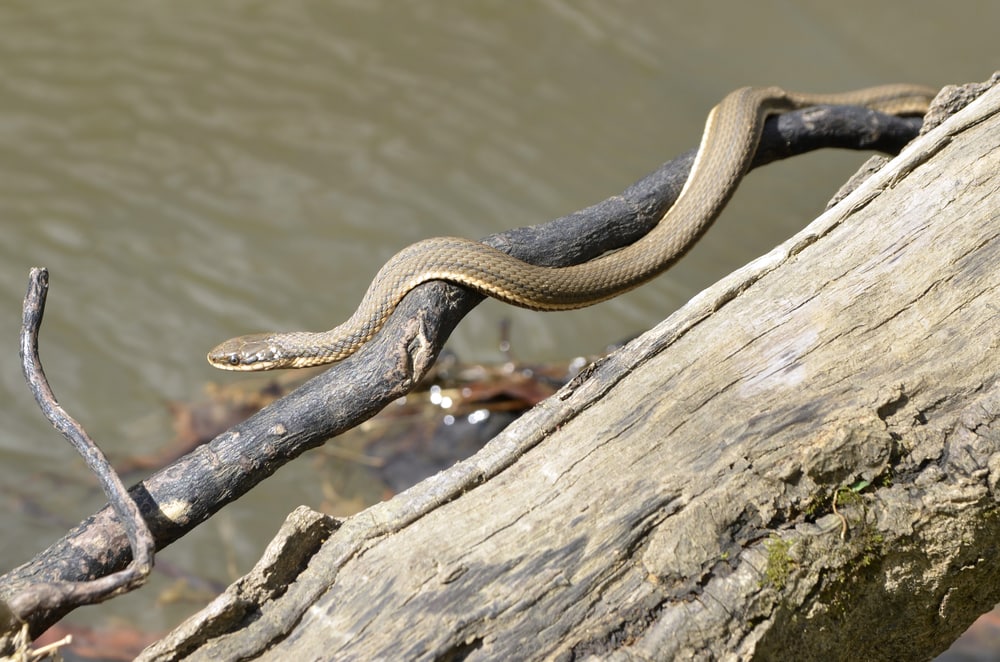
Queen snakes occur in the northern half of Georgia and the southwestern portion of the state. They live near aquatic habitats. They’re most common in the mountains and Piedmont region in the Southeast. These are slender, medium-sized snakes that average about 24 inches (61 cm) in length.
These snakes are highly aquatic and prefer living in streams, rivers, or rocky habitats with an abundance of crayfish. Their preferred diet is newly molted crayfish that are still soft.
Queen snakes are solid in color on their backs, ranging from light brown to olive green. They have a yellowish belly, which can usually be seen on the sides.
12. Striped Crayfish Snake
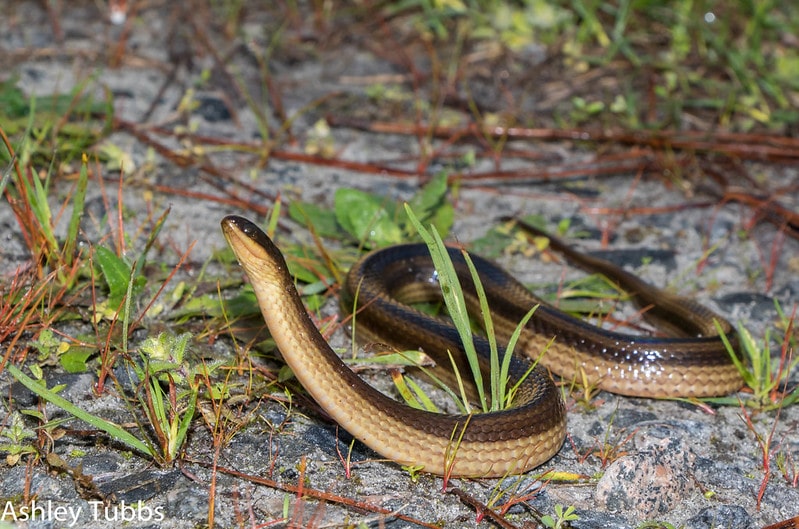
Striped crayfish snakes are highly aquatic, heavy-bodied snakes. They average about 14-20 inches (36-51 cm) in length. These snakes are most common in Florida, but their population creeps up into the southernmost portion of Georgia.
Striped crayfish snakes aren’t usually seen by humans. They’re very secretive and often hide in vegetated water habitats. Their preferred diet is hard-shelled crayfish.
They range in color from brown to dark green and have a shiny appearance. Their underbelly can be yellow to orange with dark spots running down the center.
13. Brown Snake
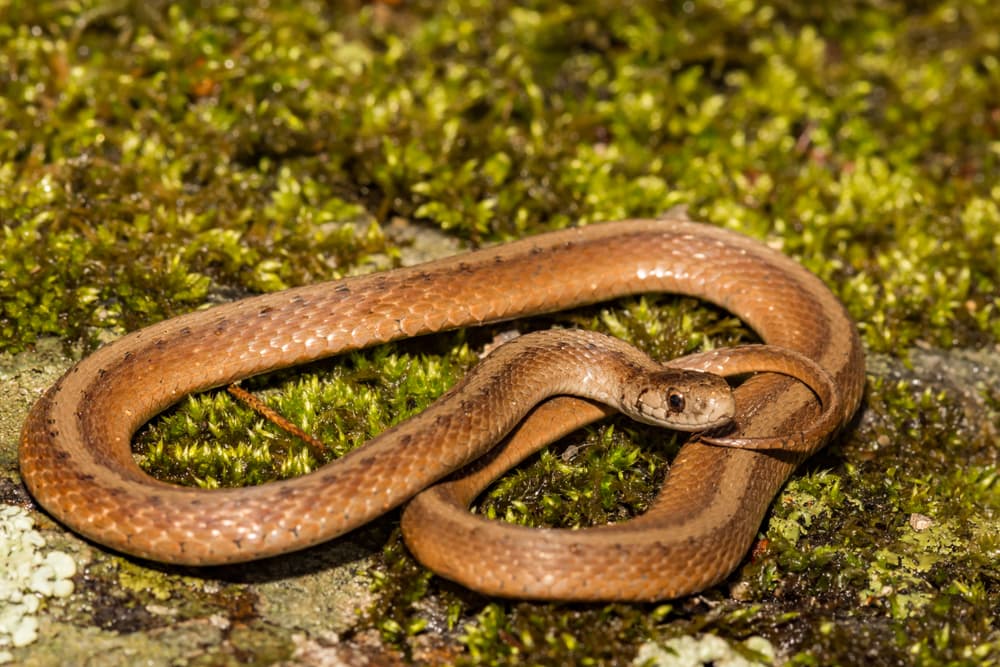
Brown snakes are one of the smallest snakes in Georgia. They range between 6-13 inches (15-33 cm) in length.
As their name suggests, these snakes usually have a brown background color. They can also be yellowish, reddish-brown, or grayish-brown. They have two rows of spots that extend along the sides. This creates a checkerboard-like pattern, which is absent from the spine.
In Georgia, the brown snake can be found in the Piedmont and Coastal Plain regions. They prefer wet habitats in the Coastal Plain region and woodlands of the Piedmont.
Brown snakes are very common in urban areas. They seek shelter under leaf litter, logs, and other debris. They’re most active in the evening and at night. Most of their diet consists of slugs, earthworms, and other soft invertebrates.
14. Black Swamp Snake
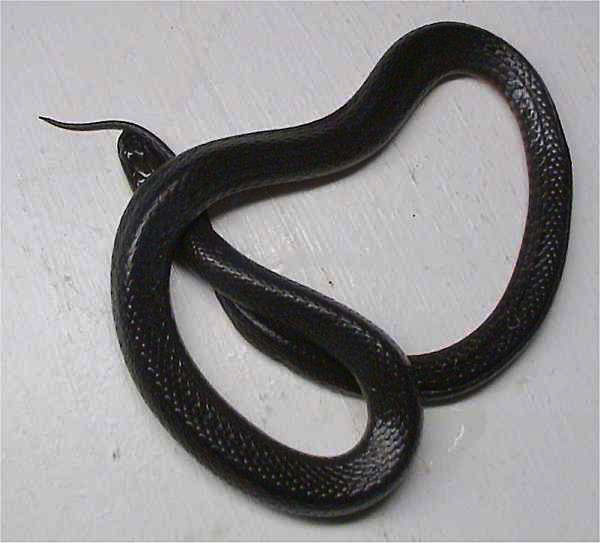
Black swamp snakes are common along the Georgia coast and the southern region of the state. They’re highly aquatic and mainly found in bogs, ponds, lakes, and ditches with heavy vegetation. Most of their diet consists of tadpoles, small fish, and aquatic salamanders.
These snakes are active during the day and night. But they’re pretty secretive and not seen often.
Black swamp snakes have a unique appearance. They’re shiny black above and have a bright red underbelly. Black swamp snakes have an average length of 22 inches (56 cm). Females are larger than males.
15. Red-Bellied Snake
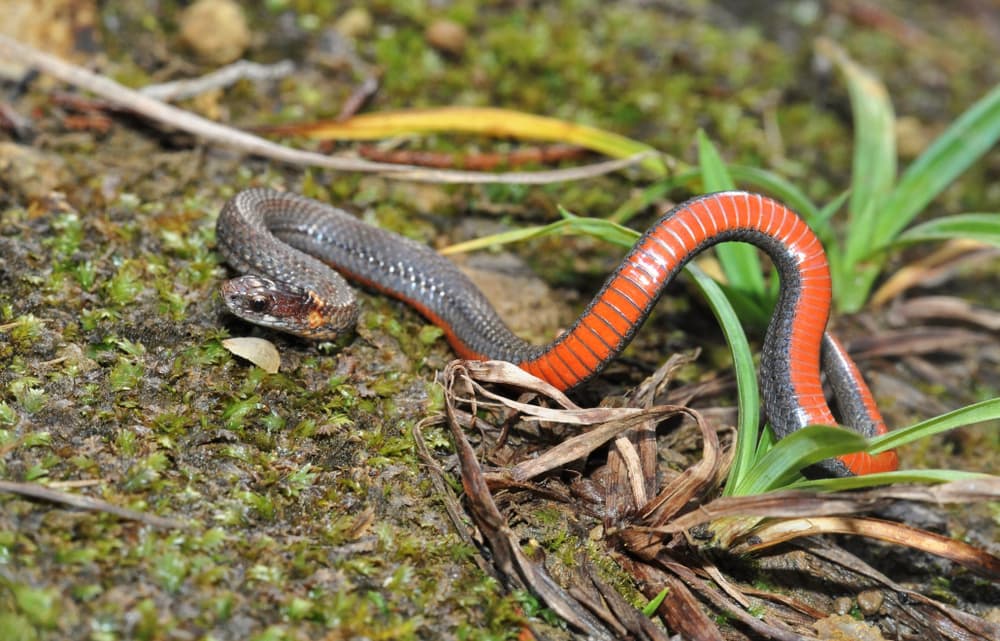
Red-bellied snakes are widely distributed throughout the state of Georgia in woodland habitats. These are small snakes, ranging between 4-10 inches (10-25 cm) in length.
Similar to the black swamp snake, these snakes have a red to orange underbelly. They can range in color from brown, gray, black, or bright orange. Some individuals have a light brown, gray, or orange stripe going down their spine.
These snakes are most common in forested habitats with coverage. They can also be found scattered throughout wetlands in the Coastal Plain. They like to hide under leaf litter, rocks, and other debris. Their preferred diet is slugs.
16. Eastern Garter Snake
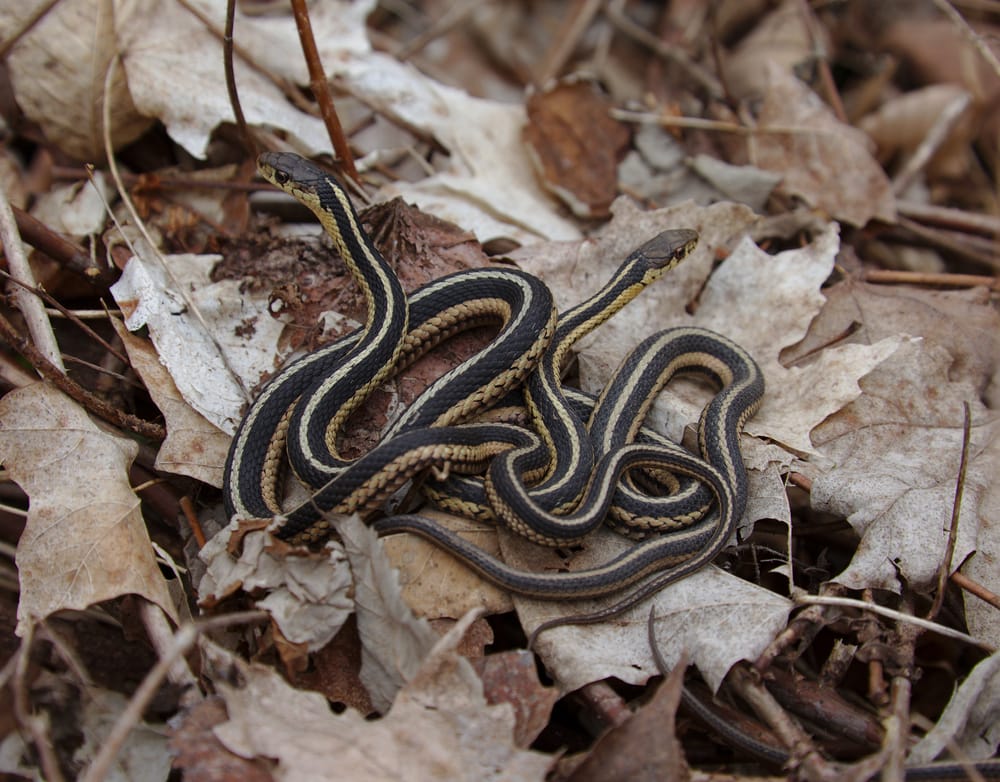
Also known as the common garter snake, the eastern garter snake occurs all throughout Georgia. They have a dark background coloration with three yellow stripes present on their spine and sides. Some individuals in southern Georgia and Florida have a bluish background color.
These snakes are similar in appearance to ribbon snakes. However, ribbon snakes are more slender. Garter snakes are medium-sized, reaching an average length up to 26 inches (66 cm).
These snakes are active during the day or night. They stay active year-round and will venture out on warmer days in the winter. They live in a wide variety of habitats.
Common garter snakes can be found in woodlands, hillsides, marshes, and meadows. They prefer moist, grassy environments near water. Most of their diet consists of amphibians, slugs, earthworms, fish, and tadpoles.
17. Ribbon Snake
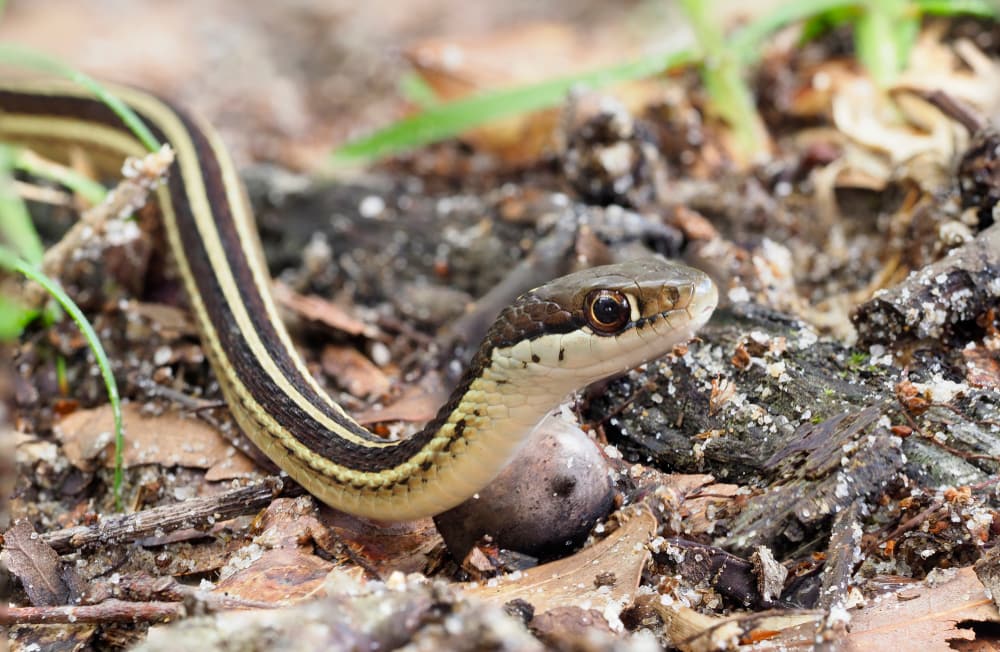
The ribbon snake is very common throughout most of Georgia, except the northwestern corner of the state.
There are four subspecies of ribbon snakes. Two of these subspecies occur in Georgia. This includes the eastern ribbon snake and southern ribbon snake.
Ribbon snakes are very similar in appearance to the common garter snake. Both possess a dark background with three yellow stripes on the spine and sides. Ribbon snakes are more slender. They can reach lengths up to 28 inches (71 cm).
Ribbon snakes occur all throughout the eastern US, except the Appalachian mountains. They’re most common in the Piedmont and Coastal Plain regions.
18. Rough Earth Snake
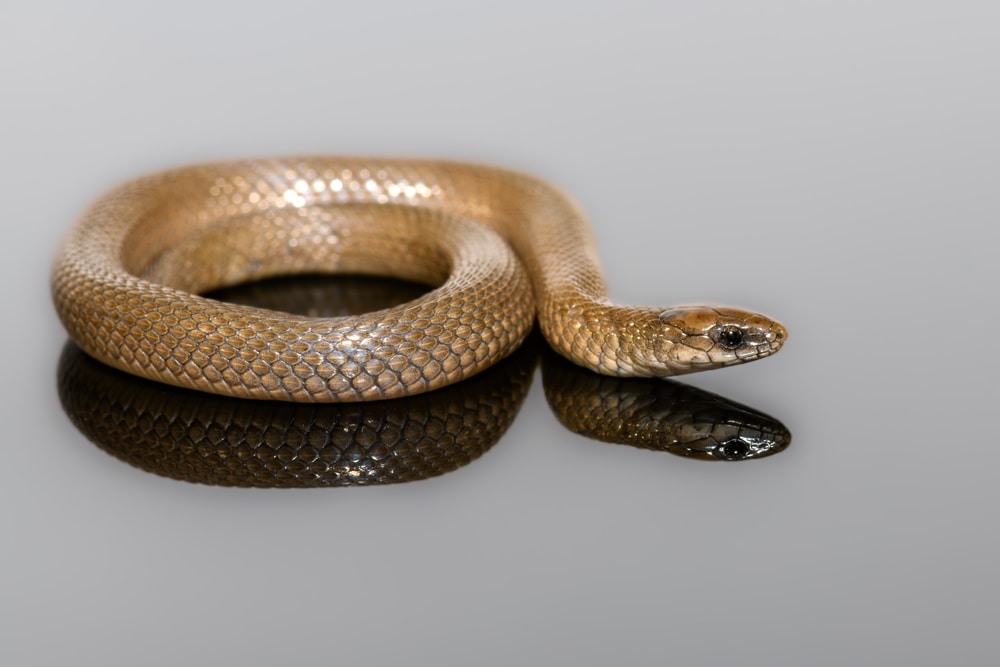
Rough earth snakes are small, slender snakes that reach up to 10 inches (25 cm) in length. They have a small head and pointed snout. Most adults are brown to gray. Juveniles are usually darker in color. The underbelly is tan to white.
Rough earth snakes live in forested habitats in the Coastal Plain region of the southern US. Their population is scattered throughout Georgia. They’re absent in northern Georgia and a small portion of the southwestern corner bordering Florida.
These snakes spend most of their time living underground or under coverage, such as logs or leaf litter. Their diet mainly consists of earthworms.
19. Eastern Hognose Snake
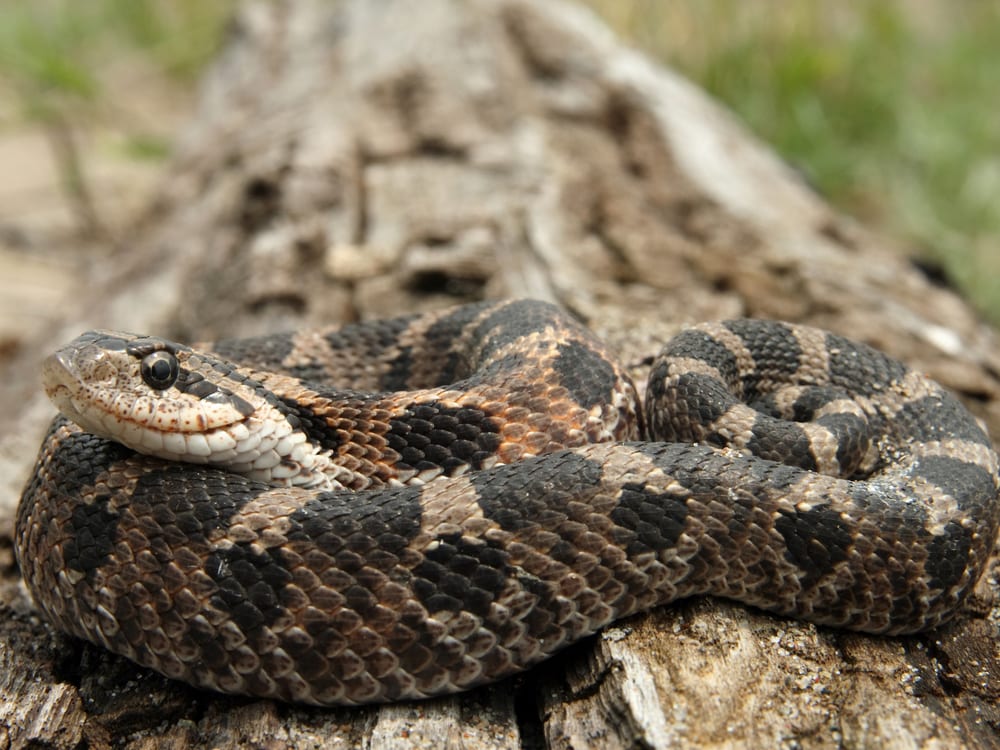
The eastern hognose snake is a large, thick-bodied snake that reaches lengths up to 46 inches (117 cm).
They’re easily recognizable by their upturned snouts. Their background color can vary between yellow, brown, green, black, or gray. They have large light brown to black rectangular spots scattered along their back.
These snakes are found in the eastern US. Their range extends from New England to southern Florida. They prefer to live in a variety of woodland habitats, and also occur in coastal areas. Eastern hognose snakes are widely distributed throughout Georgia. They’re not known to bite if encountered.
20. Worm Snake
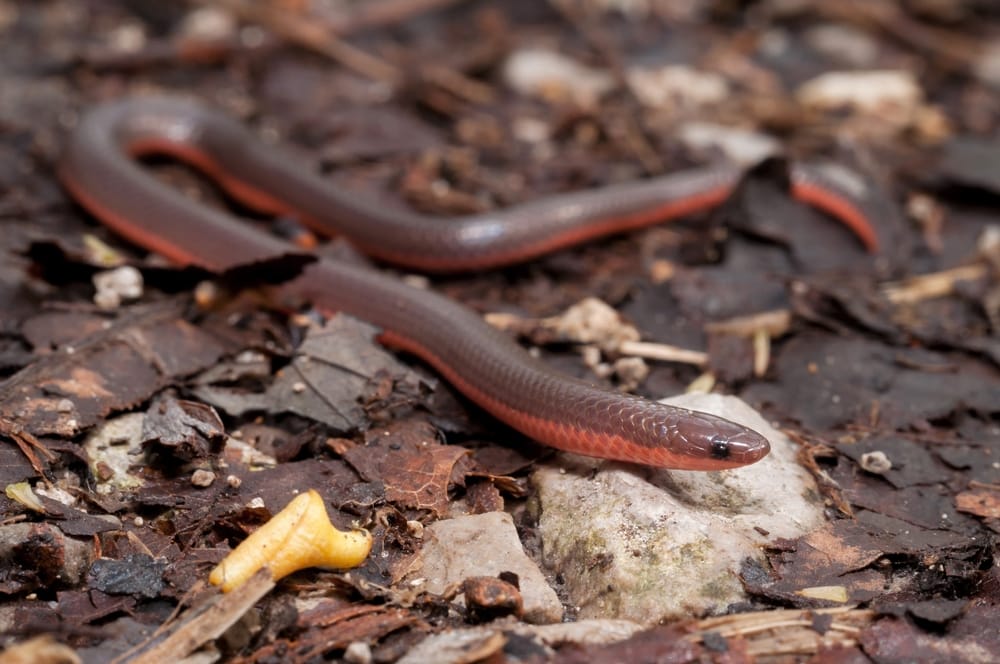
The worm snake is one of the smallest snakes in Georgia. They’re typically 7-13 inches (18-33 cm) long. They’re uniformly light to dark brown in color with a pinkish to white underbelly. As their name suggests, these snakes look like giant worms.
Worm snakes are found in forested habitats, especially in deciduous woodlands. They’re fairly common in the Piedmont region. Smaller populations also occur in the mountains.
These snakes are fossorial. This means they spend most of their time underground. They can also be found hiding under ground coverage. Worm snakes mainly eat earthworms.
They fall prey to a wide variety of creatures, including other snakes, mammals, and birds.
21. Ringneck Snake
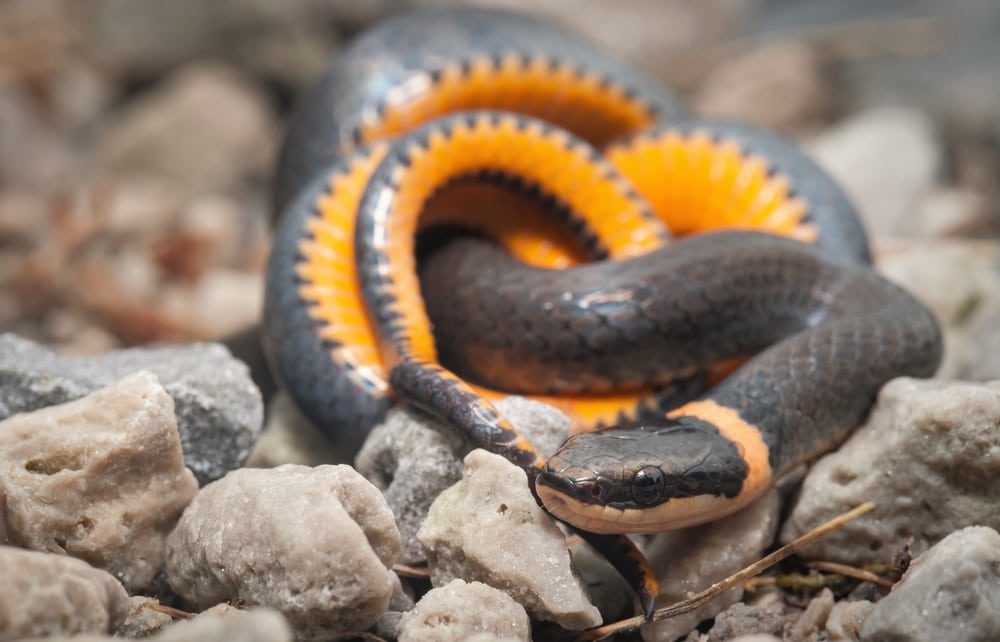
Ringneck snakes are small and slender snakes. They average between 10-15 inches (25-38 cm) in length. Ringneck snakes are uniformly dark gray to black in color. They possess a yellow or orange ring around their neck, giving this species its name.
There are two subspecies of ringneck snakes. These species include the northern ringneck and southern ringneck.
These snakes are fairly common throughout most of the eastern US. They live in a wide variety of wooded habitats, including hardwood forests.
Ringneck snakes aren’t poisonous to humans. They do have a weak venom they inject into their prey. Most of their prey consists of invertebrates, amphibians, lizards, and small snakes.
22. Mud Snake
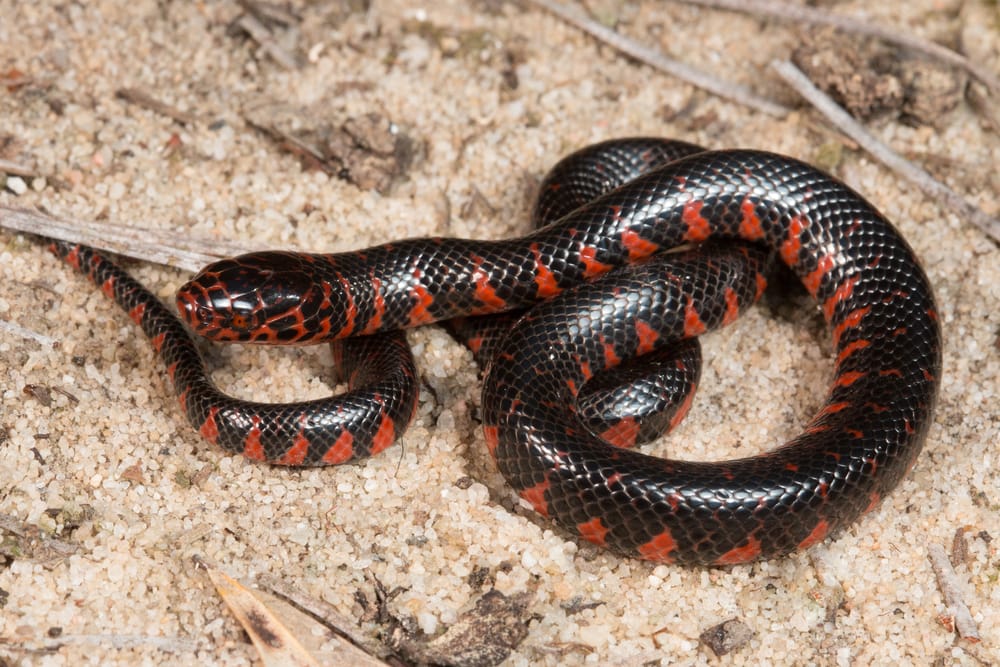
Mud snakes live in the Coastal Plain region of the eastern US. They can also be found in parts of the Piedmont region in western Georgia. They live in aquatic habitats, including swamps, marshes, wetlands, and heavily vegetated ponds and lakes.
Unlike some semi-aquatic and aquatic snakes, mud snakes don’t bask on rocks or overhanging vegetation.
They’re uniformly black with shiny, smooth scales. Their underbelly is bright red or pink. Juveniles look like miniature adults, but their underbelly coloration extends farther up the sides.
23. Black Racer
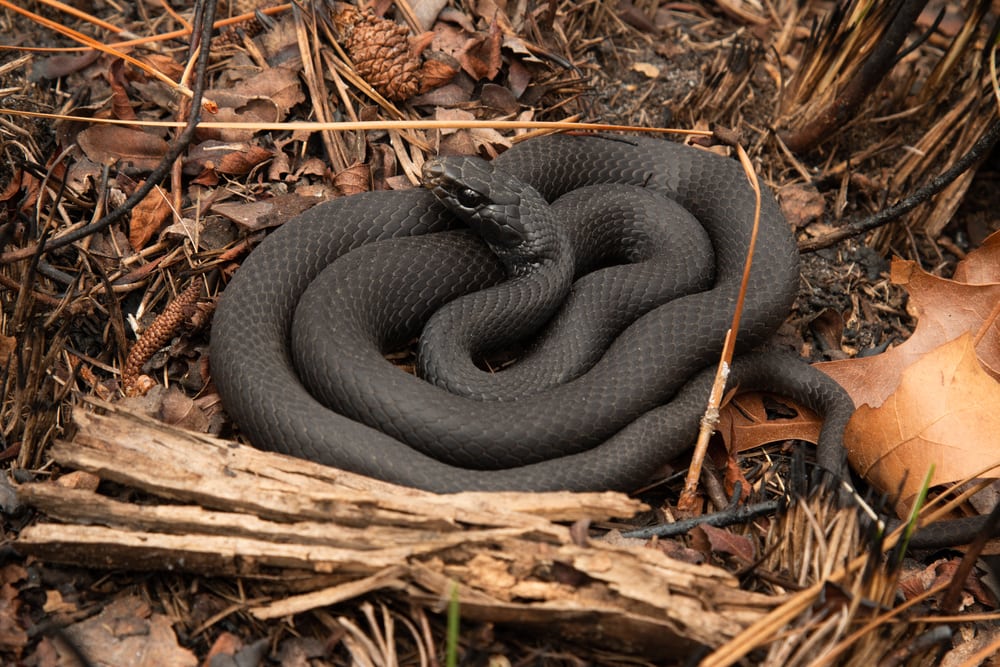
Black racers are one of the black snakes in Georgia. They’re quite large, reaching lengths up to 60 inches (152 cm). Their underbelly is also dark gray or black. Some individuals can easily be identified by white coloration on the chin.
Black racers are widely distributed throughout Georgia. They’re also found in many parts of the eastern US. They’re most active during the day and in warmer weather.
In cooler months and at night, they seek shelter in abandoned burrows. Although these snakes are non-venomous, they will bite if they feel threatened.
24. Rough Green Snake
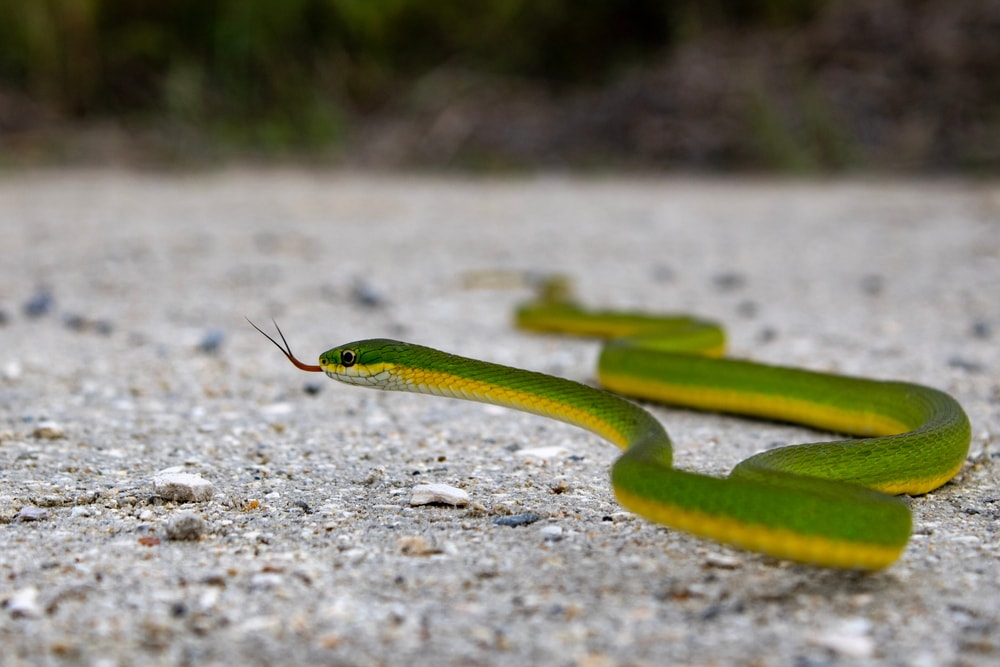
Rough green snakes are one of the most recognizable snakes in Georgia because of their color. They’re bright green with yellow to white bellies. These are long, slender snakes that can reach lengths up to 34 inches (86 cm).
If you ever find a dead rough green snake, it can easily be mistaken for a small black racer. This is because rough green snakes turn a bluish black color when they die.
Rough green snakes are widely distributed throughout various habitats in Georgia. They can be found in open forests and forest edges, wetlands, and along rivers.
They’re an arboreal species that spends most of its time hanging out in high trees and vegetation. Their bright green color comes in handy as camouflage. They often rely on this for defense, as they often freeze if encountered.
25. Corn Snake
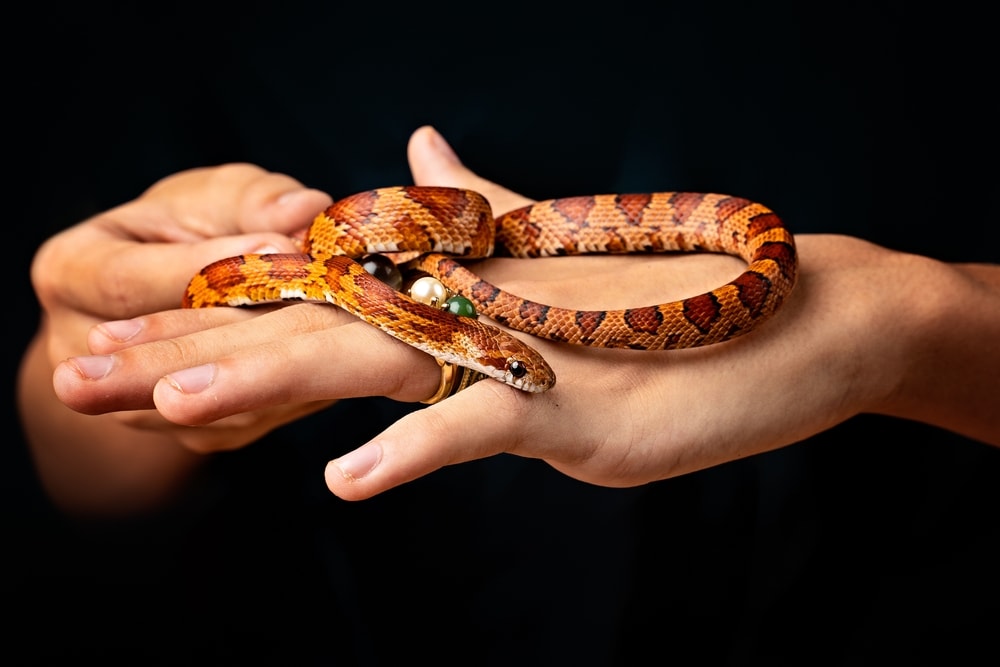
Corn snakes are large snakes commonly found in the Coastal Plain region of the eastern US. scattered populations also occur in the Piedmont region and mountains.
Copperheads and corn snakes are often confused with each other because of their similar colors and patterns.
Corn snakes vary between orange, reddish-brown, and gray. They have rectangular brown to reddish blotches outlined with black along their back. Copperhead blotches aren’t round or rectangular.
Corn snakes are a terrestrial species. Their preferred habitat is sandy pinewoods. They can also be found in agricultural and suburban areas. They’re good climbers, but spend most of their time underground or hidden by ground coverage.
Corn snakes are active during the day and night. They become more active at night during the summer.
26. Rat Snake
Rat snakes are widely distributed throughout the eastern and midwestern US. They occur in every southeastern state. Two subspecies of rat snakes occur in Georgia. This includes the yellow rat snake and gray rat snake.
The yellow rat snake is found in the northern half of Georgia and the Coastal Plain region. The gray rat snake is found in the southwestern region of the state. Populations of the two subspecies integrate in between these two regions.
Rat snakes are large snakes ranging between 30-60 inches (76-152 cm) in length. Most individuals are uniformly black above. Some rat snakes have faint white coloration scattered on their scales.
These snakes are common backyard visitors. They often alarm people because of their large size, but aren’t poisonous. Rat snakes live in a wide variety of habitats, inducing hardwood forests, barns, suburban areas, and swamp edges.
These snakes are very helpful in reducing pest populations around the home. They feed on mice, rats, squirrels, amphibians, birds, and bird eggs. They have a constrictor feeding style to capture and eat their prey.
27. Common Kingsnake
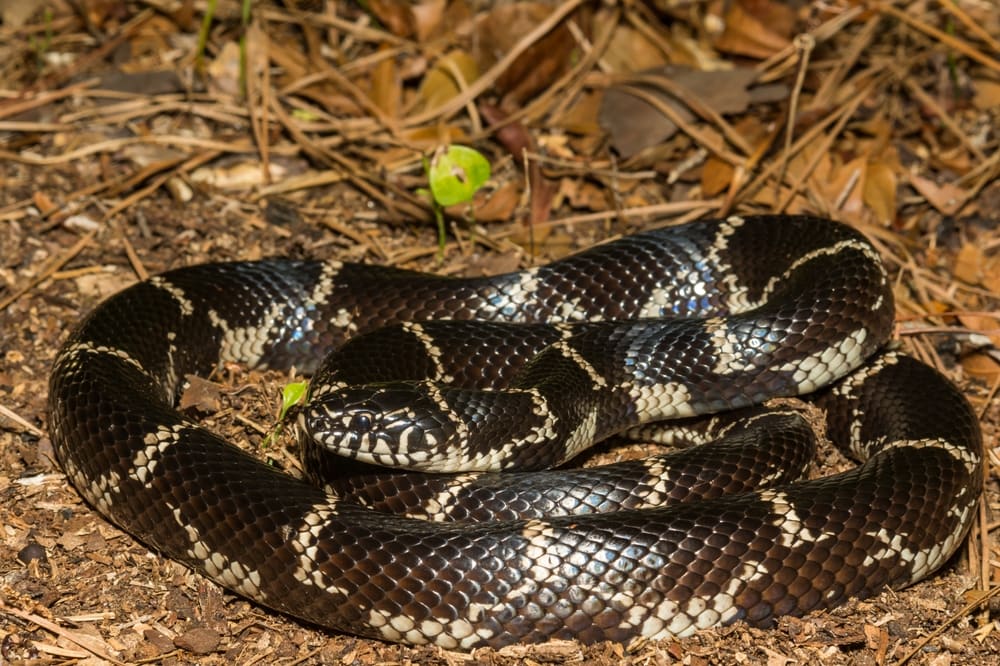
Referred to as the eastern kingsnake, the common kingsnake is found throughout most of Georgia. They occur in a wide variety of habitats, including hardwood and pine forests, wetlands, suburban areas, and farmlands.
Eastern kingsnakes are black with a series of white or yellow bands down their body. Their appearance can differ depending on where they live. Coastal Plain populations have wide white bands. Mountain populations are thinner bands, or sometimes completely black.
These snakes can reach lengths up to 48 inches (122 cm). They’re strong constrictors that feed on a wide variety of prey. Their diet mainly consists of rodents, birds, eggs, and lizards.
Common kingsnakes have a unique defense against venomous pit vipers. They’re resistant to its venom, which allows them to eat these types of snakes.
28. Milk Snake
There are 25 subspecies of milk snakes that can be distinguished by their color patterns. In Georgia, there are two subspecies of milk snake.
The eastern milk snake occurs in the northernmost region of Georgia. The scarlet kingsnake occurs throughout the rest of the state. Scarlet kingsnakes are much smaller than milk snakes.
They reach up to 20 inches (51 cm) in length. Eastern milk snakes can reach up to 35 inches (89 cm) in length.
The scarlet milk snake is vibrantly colored with alternating bands of red, black, and yellow. These snakes can be confused with the eastern coral snake because of their similar color and band pattern.
However, red bands touch black in milk snakes. Red bands of eastern coral snakes touch yellow, but never black.
29. Eastern Indigo Snake
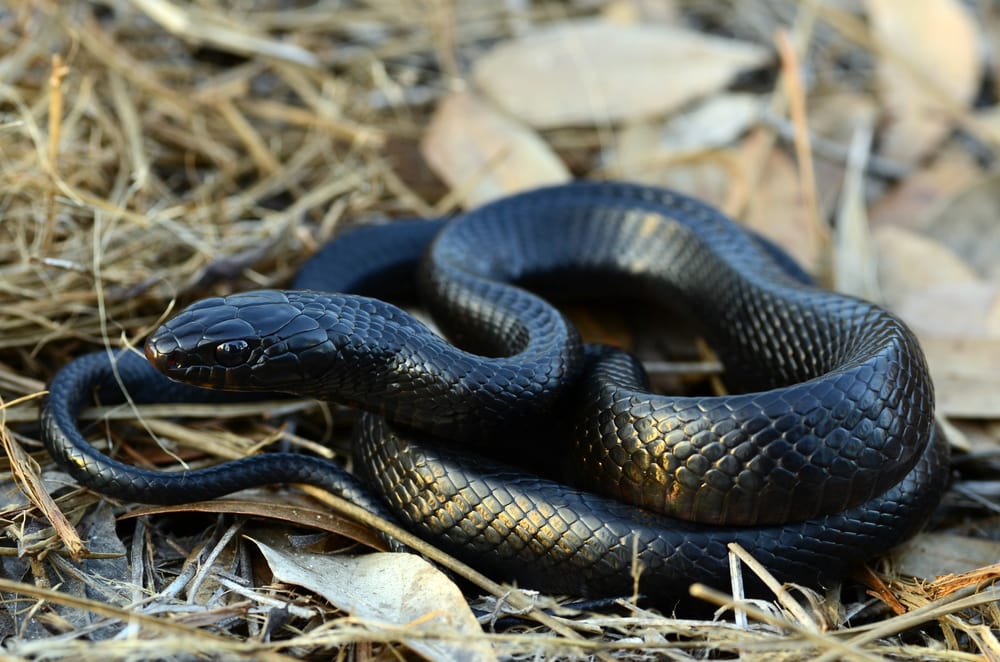
The eastern indigo snake is a large black snake in Georgia. It’s named for its shiny bluish-black coloration. Most individuals have a hint of reddish or orangish-brown on the sides of their heads and chin.
The range of eastern indigo snakes is limited to the southeastern US. They’re mainly found in Florida and southern areas of Georgia, Alabama, and Mississippi. They favor living in xeric pine oak sandhills.
These snakes are active year-round and mate during the winter. These snakes don’t resemble any venomous snakes in Georgia. However, they can mimic a rattlesnake’s defense mechanism by making rattling sounds with their tail.
30. Brahminy Blind Snake
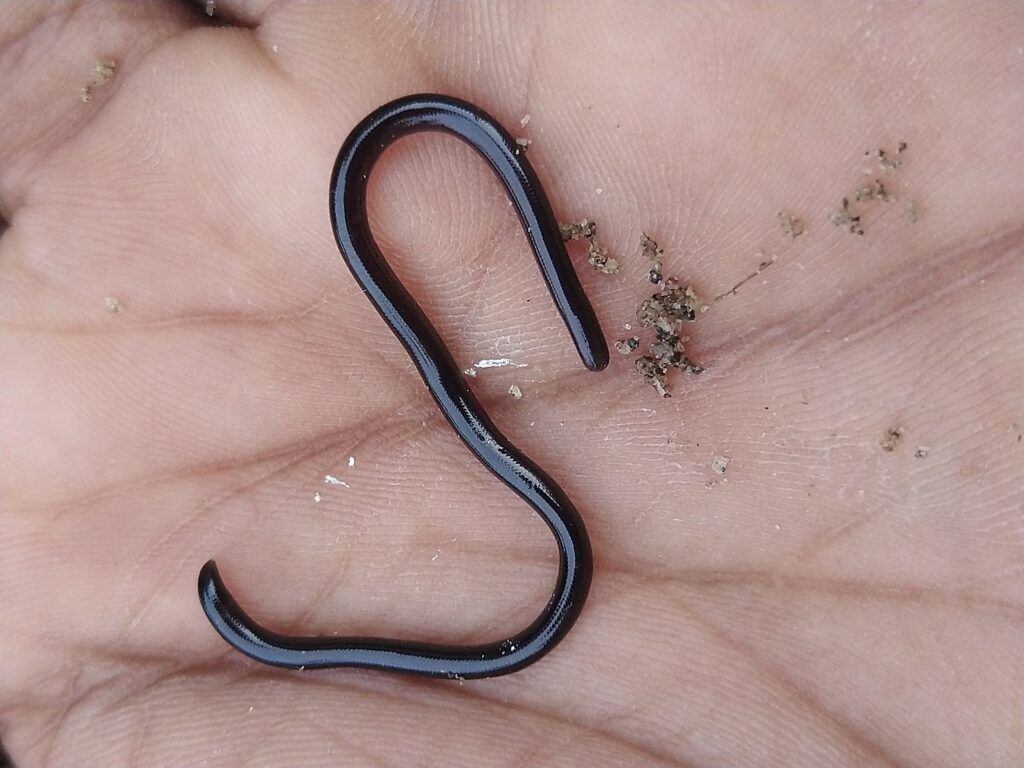
The brahminy blind snake is considered an invasive species in the US. It originates from southern Asia. These snakes were first reported in the US in the 1970s in Miami, Florida. They’re very small snakes, reaching an average length of 6.5 inches (16.5 cm) or less.
Small individuals are often mistaken for big earthworms. They’re slender and can be gray, black, or muted purple. It’s difficult to distinguish the head from the tail because both ends are round.
Brahminy blind snakes are considered harmless and typically flee if encountered. They live most of their life underground in urban and agricultural areas. They often seek shelter under debris piles, logs, rocks, or loose soil.
You may also like: 21 Different Types Of Rattlesnakes Species: Pictures And Guide
Snakes in Georgia FAQs
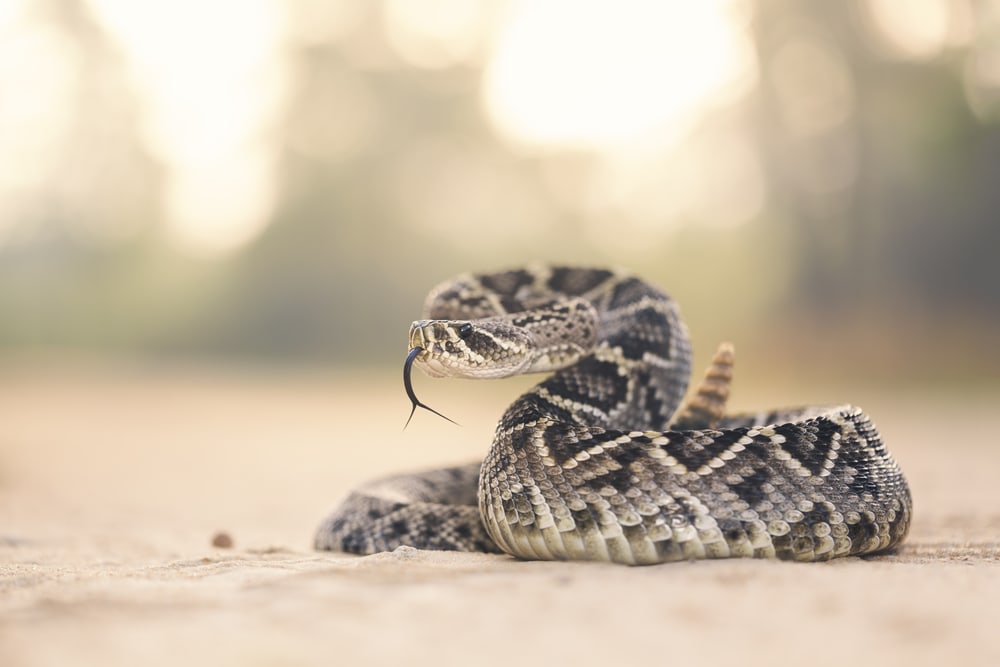
How many snake bites occur per year in Georgia?
According to the Georgia Poison Center, they receive hundreds of calls for snake bites every year. It’s estimated that 7,000-8,000 people are bitten by venomous snakes in Georgia each year.
Most of the calls that the Georgia Poison Center received in 2016 were the result of copperhead bites.
Where do snakes go in the winter in Georgia?
Many snakes in Georgia go into a dormant state called brumation. They become less active and seek shelter in abandoned burrows or ground coverage. Some snakes don’t brumate during the winter, such as the eastern indigo snake.
Is killing snakes illegal in Georgia?
Most snakes in Georgia are protected by the state. It’s illegal to kill non-venomous snakes in Georgia.
What is Georgia’s deadliest snake?
The eastern diamondback rattlesnake is considered the deadliest snake in Georgia because of the lethal venom they can inject. They’re also the most venomous snake in North America.
Is Georgia an ideal habitat for snakes?
Yes, Georgia has a wide range of excellent habitats for snakes. It’s considered to have one of the highest biodiverse snake populations in the US.
Its varying terrain provides habitats for many different species. It has a coastal region to semi-aquatic and aquatic snakes, an abundance of forests and woodlands, grasslands. and mountains.




